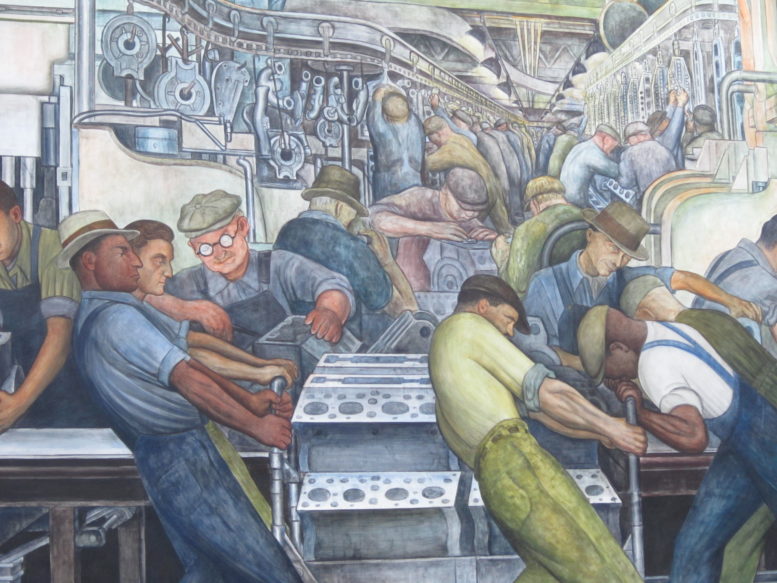By DAVID DUPONT
BG Independent News
Rebecca Kinney only realized she should write about her hometown of Detroit when she was living to the West Coast.

Rebecca Kinney
Kinney grew up in Royal Oak, just north of the city, hugging Woodward Avenue. She remembers watching the fireworks explode over the Detroit River from the National Bank building downtown. She remembers how far the city seemed though it was just a 20-minute drive from her home. And she remembered being impressed by the change in architecture, the towering, imposing structures in the city compared to the single-family scale of the suburbs.
Living in San Diego and San Francisco, she found everyone had something to say about the place where she grew up. Even if they’d never been to Detroit or even the Rust Belt, they knew, or thought they knew, something about the place. That made Kinney wondered: where did they get these ideas?
Everyone knows this, she was told. What everyone knew was that Detroit had once been an industrial powerhouse, and then it fell into ruin. But now, it was on the rise.
News magazines ran front page stories on its advertised rebirth. Photographers captured the city’s ruined beauty, depicting it as a new frontier. Chrysler celebrated it in Super Bowl ads.
At the time her writing focused on Chinatowns in other cities, now her attention turned back home.
“For me it was the first city I ever experienced,” Kinney said in an interview with BG Independent. “It’s a city I always compare other cities to, which is strange because until 10 years ago it wasn’t considered a city. It was considered a dead city, a dying city, a place where by all accounts nothing was happening. … Writing it off as a dead city suggests that the 670,000 people who lived there did not exist.” Detroit is still the 21st largest city by population in the nation.
And what then does it mean, to say that the city is now reviving?
Kinney’s analysis and study of those questions resulted in the book “Beautiful Wasteland,” which was published by the University of Minnesota Press this fall.
The image of Detroit as a frontier, as depicted in the photographs she discusses in the chapter “Picturing Ruin and Possibility,” served to set up the city as a place ripe for development. That’s akin to way the American West was depicted, just as in that frontier, it was not an uninhabited land, but as portrayed as such “to make Manifest Destiny happen.”
Now that narrative of frontier opens up Detroit, or at least the 7.2 square miles in the center of it, up for development.
“Beautiful Wasteland” explores the way that narrative, the Detroit story, was created through social media, books, documentary films and advertisements.
The decline of Detroit, Kinney said, pushing back at a common theory, predates the 1967 turmoil. Whites had already been fleeing the city for decades, a process she chronicles through social media posts in the chapter “It’s Turned into a Race Thing.” Money didn’t leave Detroit, she said, it just was funneled into the outlying suburbs, which became some of the richest in the country.
That led to a disinvestment in the city, its services and people. And a history of police brutality culminated in the 1967 rebellion, she said.
The turning point in the city came in 2008 when the housing market had crashed, and the federal government under George W. Bush moved in to bail out Chrysler.
“It was a heady moment,” Kinney, who teaches in Bowling Green State University’s School of Cultural and Critical Studies, said. Just as Detroit was a national symbol of a robust economy in the 1950s, now it stood as a symbol for the nation’s ability to pull itself together and comeback.
“We want Detroit to succeed so bad,” Kinney said. “We can point to it as a place that had fallen so far. If this city, if these people, can be on an upswing, we all can. … It was such an alluring narrative symbol, you see it played out again and again.”
That “comeback” was fueled by an infusion of private capital, notably $1.2 billion from Quicken loans founder and Detroit native Dan Gilbert, as well as public tax incentives. Many given with little or no public scrutiny. The most recent is a plan to move the Detroit Pistons into a new downtown arena.
The development in that core of the city is “astounding,” Kinney said.
In the meantime, the public schools are in crisis and there is no regional transit authority to help people from the city move to employment in the outskirts.
An area just south of Wayne State University and the central city that was once the place for drug treatment centers, the location where people with no resources, and no other place to go, were dumped, is now a hive of building activity, with the restaurants, coffee houses and parking tickets that go with gentrification.
Detroit represents a new model of gentrification. Before it would be individual urban pioneers moving into a depressed neighborhood, and it develop one artist‘s loft at a time. The arrival of corporate developers, Kinney said, would signal the culmination of gentrification.
But in Detroit, Gilbert moved Quicken Loans into the central city from the suburbs, bringing along with it thousands of employees. They bought condos he developed using mortgages from his company and then bought coffees and meals and attended yoga classes in the mixed use retail properties he had developed.
At the first Detroit Homecoming event, which brought wealthy former residents back to the city to discuss its future, Warren Buffett likened Detroit to New York City in the 1970s. Development and tourism was leveraged to bring development back to a city on the skids. While that statement was intended as a promise, Kinney sees it as a warning.
While such redevelopment is good for local elites, regional investors and multinational corporations, it doesn’t benefit the long-term residents, she said. Now New York is a city that’s not only unaffordable to the poor and working class, but for the middle class as well.
Though, she doesn’t address it in “Beautiful Wasteland,” she believes the demand for fresh water will be an issue that drives the future of Detroit. “That proximity to water is key.” Concern for safe water drove the protests over the Dakota Access Pipeline. The Flint water crisis showed how “corruptible” water is.
These urban development issues have long interested the 37-year-old Kinney. She worked with a redevelopment agency while still a student at the University of Michigan, and then after graduating with a degree in American Culture studies with a focus in ethnic studies and urban sociology, she continued that work in San Francisco, before going to graduate school where she further pursued her interest in the culture and racial dynamics of cities. “Those interests have always been important to me,” she said.
Kinney sees “alternative models for thinking how to grow smartly and consciously and do it at the neighborhood level. Detroit is the city of neighborhoods.”
These models serve the long-time residents, she said. “There are the Detroiters who never left, who in some ways because of this new development, are becoming invisible.”


